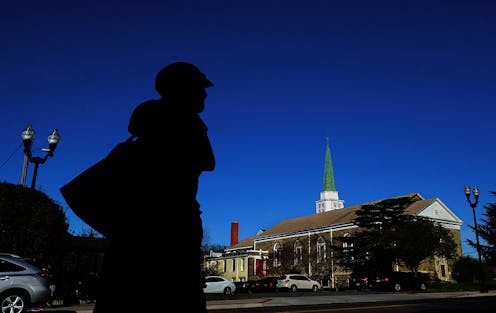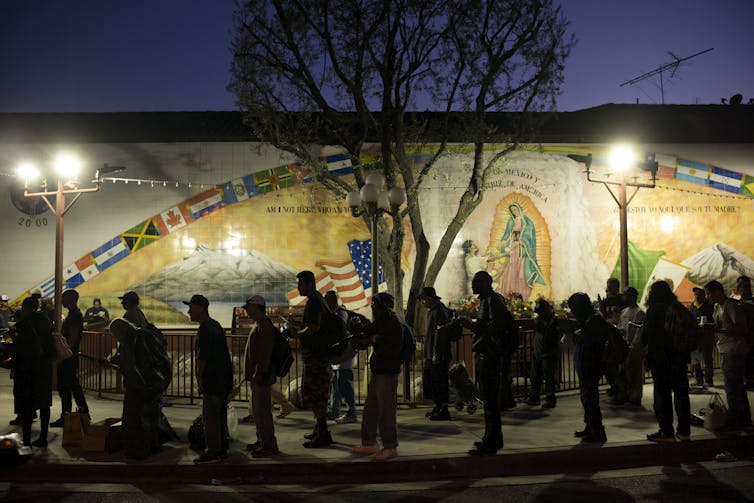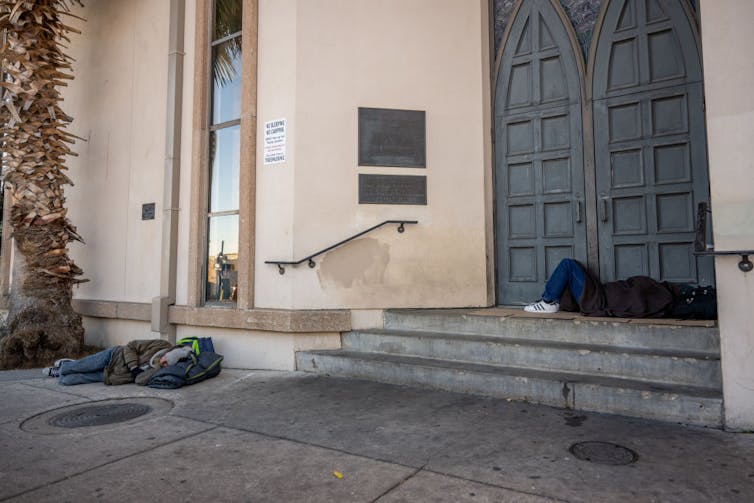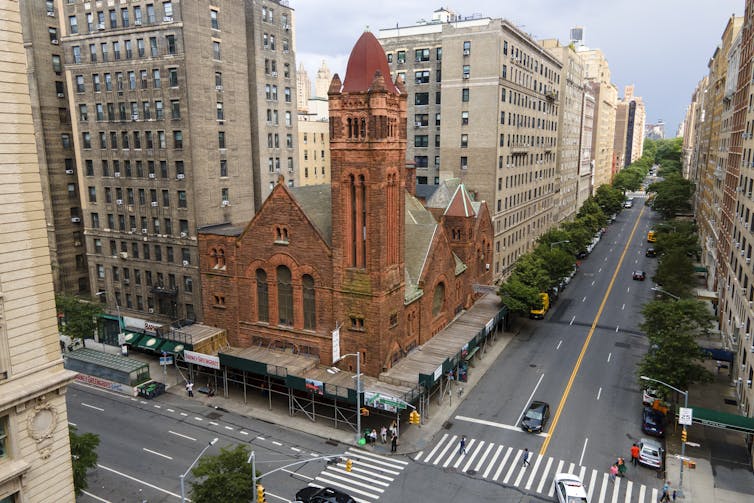Affordable housing in God’s backyard: Some religious congregations find a new use for their space
Many houses of worship no longer need as much space as they once did, or struggle to keep up with the bills. For some, redevelopment to include housing provides a new way to live out their mission.

Faced with declining membership, aging buildings and large, underutilized properties, many U.S. houses of worship have closed their doors in recent years. Presbyterian minister Eileen Linder has argued that 100,000 churches may close in the next few decades.
But some congregations are using their land in new ways that reflect their faith – a focus of my urban planning research. Some are repurposing their property to provide affordable housing, as the housing crisis intensifies across the country.
Take Arlington Presbyterian Church in Arlington, Virginia. In 2016, the church sold its historic stone building to the Arlington Partnership for Affordable Housing to construct a 6-story complex with 173 apartments, known as “Gilliam Place.” The building still houses space for the congregation, as well as La Cocina, a bilingual culinary job training facility and cafe. In Austin, Texas, St. Austin Catholic Parish is partnering with a developer to build a 29-story tower providing 200 beds of affordable student housing, in addition to new spaces for ministry.
Other houses of worship are pursuing similar projects today.
Same mission, new projects
Faith-based organizations have been building housing for many years, but generally by purchasing additional property. In recent years, however, more houses of worship are building affordable housing on the same property as the sanctuary.
This can be done in a variety of ways. Some congregations adapt the existing sanctuary and other faith-owned buildings, while others demolish existing buildings to construct a new development, which may or may not have space for the congregation. Another option is to build on excess property, like a parking lot.
Depending on how a development deal is structured, a faith-based organization may receive proceeds from the sale of its land, or from leasing their property to a developer – funds which they can then spend on ministry or on a new space for worship. If a new development includes space for the congregation, sometimes they rent out those spaces when the space is not being used for worship, which can also financially benefit the congregation.
Faith-based organizations often see these projects as a way to do “God’s work.” In some instances, they include community services beyond the housing itself.

Near Los Angeles, the Episcopal Church of the Blessed Sacrament in Placentia partnered with a nonprofit affordable housing developer – National Community Renaissance, also called National CORE – to develop 65 units for older people. The complex also includes a 1,500 square foot (140 square meter) community center. The city’s diocese has a goal of building affordable housing on 25% of its 133 properties.
For some congregations, these are mission-driven projects rooted in social justice.
In Washington, D.C., Emory United Methodist Church redeveloped its property and constructed The Beacon Center – which has 99 affordable housing units, community spaces, and a commercial kitchen that provides job training for recently incarcerated people – while preserving the sanctuary. In Seattle, the Nehemiah Initiative is working with Black churches in the Central District, a historically African American neighborhood, to redevelop its properties into affordable housing to keep residents from being displaced.
Potential to evolve
Churches have also experimented with different housing models.
In St. Paul, Minnesota, the Mosaic Christian Community, which is affiliated with the Church of the Nazarene, partnered with an organization called Settled to construct tiny homes on church property, including a bed, loft, kitchen and small closet. Peace Presbyterian Church in Eugene, Oregon, sold its property to the affordable housing nonprofit SquareOne Villages to develop Peace Village, a 70-unit development.
Peace Village uses a hybrid ownership structure that combines a limited-equity cooperative with a community land trust, and separates the cost of land from the cost of housing. SquareOne owns the land, but leases the land to the cooperative and then leases or sells housing to its members, who also manage the land – a partnership meant to keep the land affordable.
As states and cities struggle to provide affordable housing, studies have been conducted from Nashville to New York City on the amount of land faith organizations own, and their potential as housing partners.

In the D.C. metro area, for example, the Urban Institute found almost 800 vacant parcels owned by religious organizations. In California, a report from the Terner Center at University of California, Berkeley found approximately 170,000 “potentially developable” acres of land owned by religious organizations and nonprofit colleges and universities.
Legal reforms
Houses of worship trying to build housing can run into a number of challenges, including zoning. Some congregations face difficulties changing zoning codes to a new land use, minimizing parking requirements, or increasing housing density.
In response, many states and municipalities have reformed laws and ordinances. Washington State legislators ESG: describe the bill but don’t use the HB number approved a bill in April 2019 that gives religious organizations a density bonus for building 100% affordable housing on faith property – which permits an increase in the allowable number of units constructed. The same year, San Diego reduced or in some instances removed parking requirements for organizations building affordable housing in areas near public transportation hubs.
In October 2023, California lawmakers passed a bill to permit religious organizations and higher education institutions to bypass local permitting processes in order to build affordable housing on their property.
In March 2024, at the federal level, Sen. Sherrod Brown of Ohio introduced the “Yes, in God’s Backyard Act.” His “YIGBY” proposal would provide technical assistance to faith organizations interested in building affordable housing.
YIGBY vs. NIMBY
Another challenge facing houses of worship that want to develop affordable housing is community opposition.

In addition to being spiritual centers, houses of worship can be important neighborhood anchors that provide social services and space for community events. They can be aesthetically pleasing and sometimes historically significant.
In New York City, for example, West-Park Presbyterian Church has been battling the community for almost a decade over its desire to redevelop the property. The historic church is a designated historic landmark, and requires millions of dollars in repairs, which the congregation says it cannot provide.
Instead, the congregation would like to build a mixed-use facility that would include housing, as well as space for the congregation to continue providing arts programs and community activities. Under the city’s landmark regulations, however, a designated property cannot be demolished or altered.
Even when a redevelopment project faces no legal barriers, finding the needed skills or funding can be difficult. Nonprofit housing intermediaries such as Enterprise and the Local Initiative Support Corporation have formed technical assistance programs for organizations that want to create affordable housing, including houses of worship. Other nonprofit groups like Bricks and Mortals, Partners for Sacred Places and the Faith Leadership Campus, which is sponsored by Trinity Church Wall Street, also provide advice on the development process.
Despite the challenges, many houses of worship are constructing housing and changing the way people think about faith-based organizations’ role in their communities.
When thinking about the redevelopment process, Arlington Presbyterian member Jon Etherton told me, “the call from God to create, do something about affordable housing was bigger than the building itself.”
Nadia A. Mian receives funding from The Louisville Institute and Villanova University.
Read These Next
How the ‘slayer rule’ might play a role in determining who will inherit wealth from Rob Reiner and h
These rules have a long history in the United States. They played a role in the notorious murders by…
The celibate, dancing Shakers were once seen as a threat to society – 250 years later, they’re part
‘The Testament of Ann Lee,’ Mona Fastvold’s 2025 film, depicts part of the long history of Shaker…
As DOJ begins to release Epstein files, his many victims deserve more attention than the powerful me
Powerful men connected to Jeffrey Epstein are named, dissected and speculated about. The survivors,…






